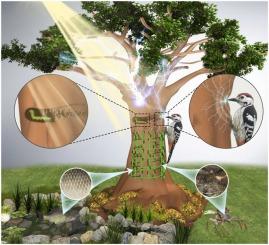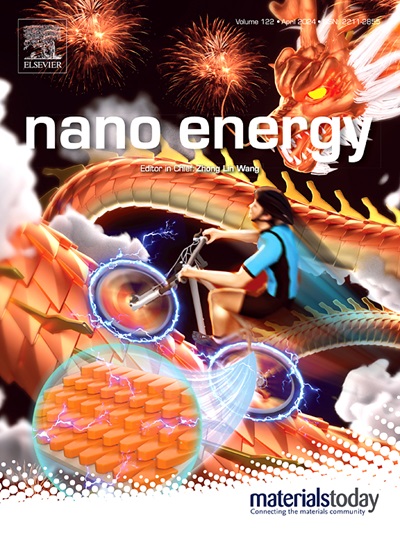Carbonyl chitosan-induced solarthermal healable and ultratough organohydrogel for dual-mode energy production/storage
IF 16.8
1区 材料科学
Q1 CHEMISTRY, PHYSICAL
引用次数: 0
Abstract
Non-carbonized photothermal conversion materials (PTCMs) created from polysaccharides are highly intriguing but unexplored for the lacked light-absorbing groups. Meanwhile, macromolecular PTCMs operate as single molecules enable optimal solar![]() thermal conversion remains challenge. Herein, we employ a molecular engineering strategy to enhance chitosan's absorption by incorporating robust-light-absorbing carbonyl groups to fabricate oxidized chitosan (OCTS) with 408 % enhancements in solar
thermal conversion remains challenge. Herein, we employ a molecular engineering strategy to enhance chitosan's absorption by incorporating robust-light-absorbing carbonyl groups to fabricate oxidized chitosan (OCTS) with 408 % enhancements in solar![]() thermal conversion efficiency due to full-spectrum solar absorption. Then the water-soluble OCTS is utilized to fabricate gelatin/OCTS/K3Cit/ethylene glycol (GOKE) polyelectrolyte organohydrogel with excellent solar
thermal conversion efficiency due to full-spectrum solar absorption. Then the water-soluble OCTS is utilized to fabricate gelatin/OCTS/K3Cit/ethylene glycol (GOKE) polyelectrolyte organohydrogel with excellent solar![]() thermal-induced self-healing, ultrastrong mechanical and antibacterial properties. The incorporation of OCTS facilitates GOKE to harvest over 98 % full-spectrum solar absorption, 92 % solar
thermal-induced self-healing, ultrastrong mechanical and antibacterial properties. The incorporation of OCTS facilitates GOKE to harvest over 98 % full-spectrum solar absorption, 92 % solar![]() thermal driven self-healing efficiency after five cycles, and tensile strength and toughness of 5.53 MPa and 9.81 MJ m
thermal driven self-healing efficiency after five cycles, and tensile strength and toughness of 5.53 MPa and 9.81 MJ m![]() 3 attributed to Hofmeister effect strategy. Encouragingly, benefiting from OCTS's excellent solar
3 attributed to Hofmeister effect strategy. Encouragingly, benefiting from OCTS's excellent solar![]() thermal conversion and polyelectrolyte properties, GOKE is assembled into solar
thermal conversion and polyelectrolyte properties, GOKE is assembled into solar![]() thermal
thermal![]() electric generators (STEG) and triboelectric
electric generators (STEG) and triboelectric![]() nanogenerators (TENG), showing dual-mode electric output (50.3 mA/16.4 W m
nanogenerators (TENG), showing dual-mode electric output (50.3 mA/16.4 W m![]() 2 for STEG and 37 V/16.2 mW m
2 for STEG and 37 V/16.2 mW m![]() 2 for TENG). Additionally, GOKE-based flexible supercapacitors exhibit energy density of 11.3 Wh kg
2 for TENG). Additionally, GOKE-based flexible supercapacitors exhibit energy density of 11.3 Wh kg![]() 1 and specific capacitance of 81.5 F g
1 and specific capacitance of 81.5 F g![]() 1, capable of storing energy generated by STEG/TENG. Noteworthy, this study pioneers polysaccharide-based non-carbonized PTCMs with potential applications in clean energy production/storage.
1, capable of storing energy generated by STEG/TENG. Noteworthy, this study pioneers polysaccharide-based non-carbonized PTCMs with potential applications in clean energy production/storage.

用于双模式能源生产/储存的羰基壳聚糖诱导的太阳热可愈合和超韧有机水凝胶
由多糖制备的非碳化光热转换材料(PTCMs)非常有趣,但由于缺乏吸光基团而未被开发。与此同时,大分子ptcm作为单分子运行,实现最佳的太阳能热转化仍然是一个挑战。在此,我们采用分子工程策略来增强壳聚糖的吸收,通过加入强大的光吸收羰基来制造氧化壳聚糖(OCTS),由于全光谱太阳能吸收,其光热转换效率提高了408%。然后利用水溶性OCTS制备了明胶/OCTS/K3Cit/乙二醇(GOKE)聚电解质有机水凝胶,该凝胶具有优异的太阳热诱导自愈、超强的机械性能和抗菌性能。OCTS的加入使GOKE获得了超过98%的全光谱太阳能吸收率,五次循环后太阳能热驱动的自修复效率达到92%,由于Hofmeister效应策略,抗拉强度和韧性分别达到5.53 MPa和9.81 MJ m3。令人鼓舞的是,得益于OCTS优异的太阳能热转换和多电解质特性,GOKE被组装成太阳能热电发电机(STEG)和摩擦纳米发电机(TENG),显示出双模式电输出(STEG为50.3 mA/16.4 W m2, TENG为37 V/16.2 mW m2)。此外,基于goke的柔性超级电容器的能量密度为11.3 Wh kg1,比电容为81.5 F g1,能够存储由STEG/TENG产生的能量。值得注意的是,该研究开创了基于多糖的非碳化ptcm在清洁能源生产/储存方面的潜在应用。
本文章由计算机程序翻译,如有差异,请以英文原文为准。
求助全文
约1分钟内获得全文
求助全文
来源期刊

Nano Energy
CHEMISTRY, PHYSICAL-NANOSCIENCE & NANOTECHNOLOGY
CiteScore
30.30
自引率
7.40%
发文量
1207
审稿时长
23 days
期刊介绍:
Nano Energy is a multidisciplinary, rapid-publication forum of original peer-reviewed contributions on the science and engineering of nanomaterials and nanodevices used in all forms of energy harvesting, conversion, storage, utilization and policy. Through its mixture of articles, reviews, communications, research news, and information on key developments, Nano Energy provides a comprehensive coverage of this exciting and dynamic field which joins nanoscience and nanotechnology with energy science. The journal is relevant to all those who are interested in nanomaterials solutions to the energy problem.
Nano Energy publishes original experimental and theoretical research on all aspects of energy-related research which utilizes nanomaterials and nanotechnology. Manuscripts of four types are considered: review articles which inform readers of the latest research and advances in energy science; rapid communications which feature exciting research breakthroughs in the field; full-length articles which report comprehensive research developments; and news and opinions which comment on topical issues or express views on the developments in related fields.
 求助内容:
求助内容: 应助结果提醒方式:
应助结果提醒方式:


